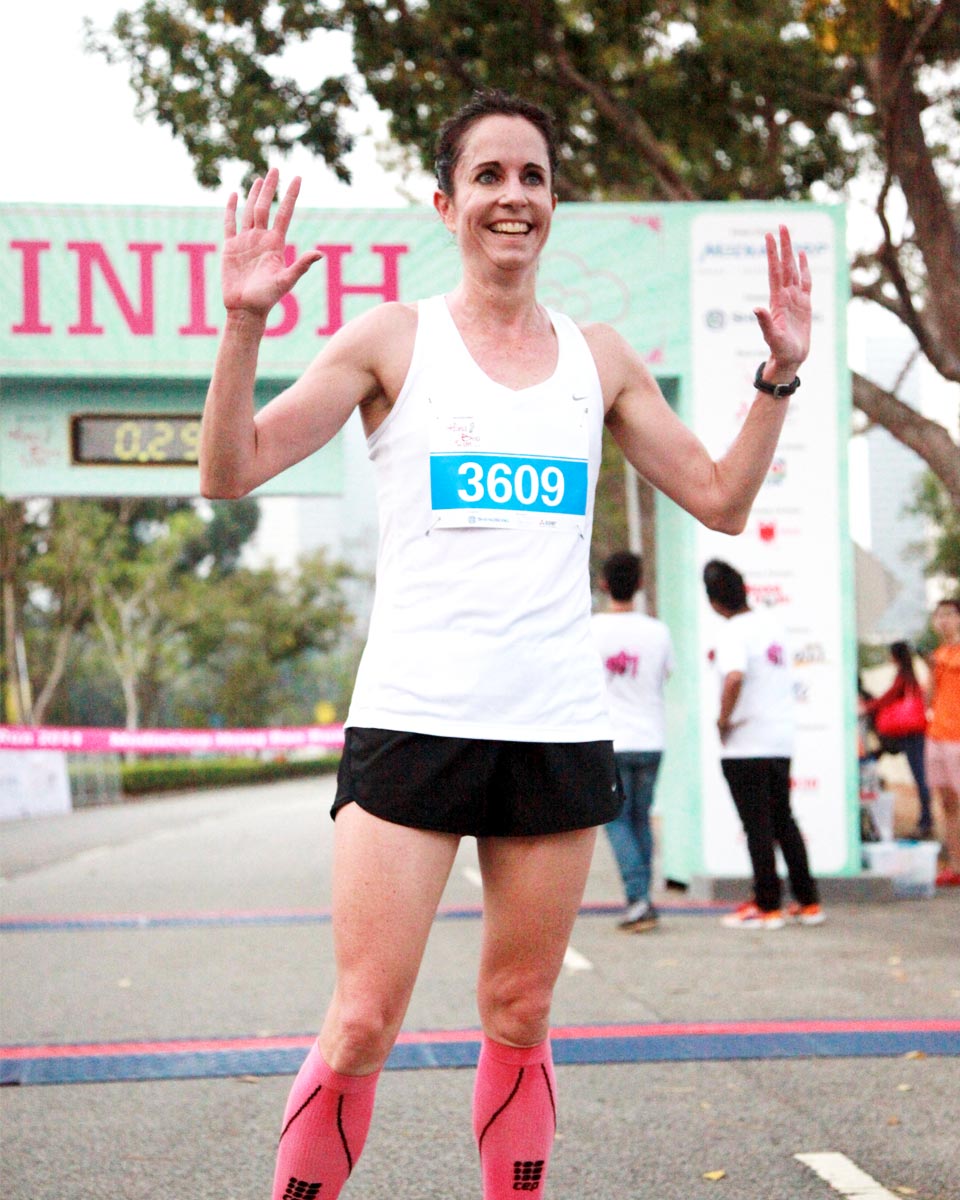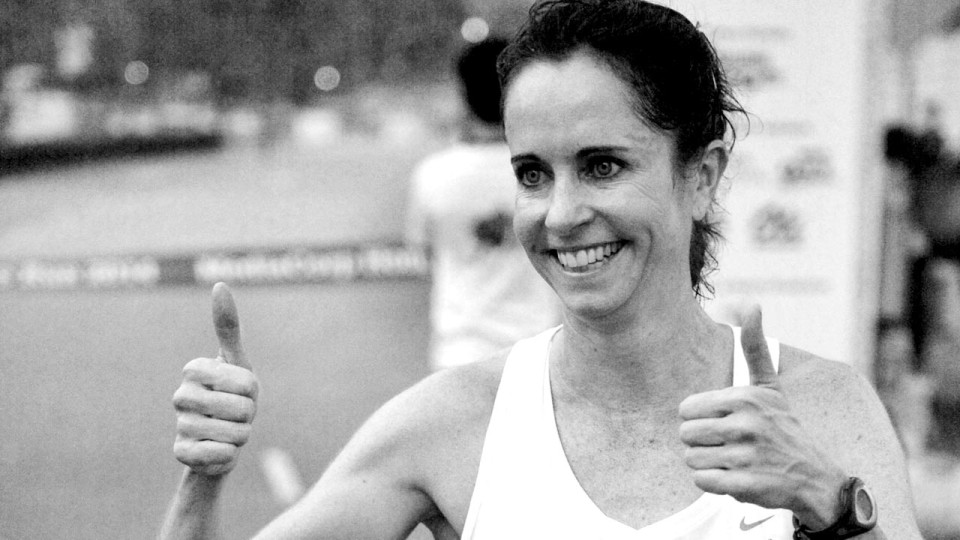Suzanne Walsham is one tenacious lady. She’s won the Empire State Building Run Up 5 times (with her most recent one in February 2014). Locally, she’s been the women’s champion for the Swissotel Vertical Marathon for an astounding 8 times!
RunSociety catches up with her to talk about how she found her love for tower running, and the secret behind her extended success.
Q: At what point of your running journey did you discover your talent in tower running?
I moved to Singapore in 2006 and my first vertical race was the Swissotel Vertical Marathon. I was looking for new challenges and I thought I could be quite strong in the stairs with my middle distance track background.
I was very pleased when I won that first race, primarily because it won me a trip to New York to compete in the Empire State Building Run Up, and I surprised myself by winning that race too. I competed in a handful of vertical/tower races between 2007 and 2009 (including Swissotel and Empire State) always placing in the top 3.
The sport has really grown and there is now a World Cup/World Circuit, so since the beginning of 2012, I have focused primarily on tower running. In the last 2 years, I have competed in 22 races all over the world and have won 20 of them.
Q: The differences in tower running and marathons are numerous, mostly in their different distances and intensity. Do you have any difference in training for tower running and more conventional runs?
Tower running is really very different from marathons, in fact at the top competing level, they are quite incompatible as they use different muscle systems (I have never done a marathon).
While I find that my stair training complements my running training (and vice versa), when I have a tower race coming up, I will be in the stairs twice per week with possibly another hill session, but if I have a road race coming up, I will swap out a stair session for a flat running session.
Because some of my vertical races can take up to 15 minutes, some of my stair training sessions take up to an hour, covering up to 300 floors, so this definitely helps my endurance for conventional runs, although my current 10km times are a bit slower than a few years ago when I was only focused on road races.
The one big bonus for me is that I am less injured when I train more in the stairs – the impact is much lower and I recover better/faster from sessions.
Q: You’re definitely not a slouch in conventional races too, with your most recent win being the Women’s 8km in the Mediacorp Hong Bao Run 2014. In fact, you’ve consistently been able to achieve top-grade performances across various events and distances. What’s your secret to running with such success for these few years?
I have been training and competing for many years so I know the training that suits me (I coach myself) and I know how to race. I train to race rather than just training to keep fit, if that makes sense, and my training program is always geared to my racing schedule.

My biggest challenge is managing injuries – I am very injury prone which has hindered my athletic career so it is a bit of a balancing act. I see a physiotherapist nearly every week and also have regular chiropractic sessions.
When I do get injured, I always keep very fit doing bike and cross training sessions so when I am able to run again, I haven’t lost any fitness.
Q: Stair climbing is an excellent exercise for conditioning runners. Any advice for those who are looking to include stair climbing as part of their exercise?
Stair climbing is a fantastic form of exercise, and with the majority of Singaporeans either living in high rises or working in high rises, there are plenty of training opportunities.
The benefit of stair climbing is that you can get a great fitness result in a short period of time, it is less stressful on the legs (although it might feel harder when you are actually doing it) and you don’t have to worry about the weather!
If you are going to try it for the first time, start with just walking/running up say 5 or 10 flights of stairs, take a little break and continue (for as tall as the building is).
Repeat this a few times depending on your fitness level. Don’t walk back down the stairs (walking down puts a lot of pressure on the knees), catch the lift.
As you get fitter/more accustomed to the stairs, you can add more floors/repetitions or reduce the recovery of the breaks or try running the stairs 2 at a time.
Q: Before you made your base in Singapore, you were originally from Australia. Are there any differences in the running cultures between the 2?
Sport in general is very much ingrained in the Australian culture, particularly at the school level, whereas at the school level here, sport definitely takes a backseat. Australia is successful at quite a broad range of sports, so athletics is competing for talent that often ends up in other sports.
When I first came to Singapore, there were only a few road races every year, but now there are races nearly every weekend and often with more than 5,000 competitors – so from a participation perspective, I think running is now more popular in Singapore than in Australia.
Singapore athletes are really improving and competing at high levels (such as South East Asia Games, World Youth Championships, Commonwealth Games etc) and I think there is a lot of potential here.

Q: Is there any particular kinds of injuries that you have to look out for when tower running? What do you do to prevent such injuries?
Actually, I don’t get injured when I do stair running and often there are times when I have had calf and hamstring strains that have stopped my flat running, but I have still been able to do stair running.
I have had very bad blisters on my hands from pulling on the handrail during training sessions, so I now wear weight-training gloves and strap some fingers with tape to stop this. It is also important to stay hydrated to avoid cramping – it hasn’t happened to me but the muscles certainly have to work hard in tower running so it is a possibility.
Q: What’s the race you’re most looking forward to this year?
The Empire State Building Run Up was a big focus for me this year (I really wanted to be the first woman to win it 5 times), but to be honest, I look forward to all the races I do.
I only enter races that I want to do, and with so many races on the calendar (both the road races here in Singapore and the tower races internationally) I really have to be selective and plan my year out.
For the tower races, I usually pick races that are going to maximize my points for the World Cup and Vertical World Circuit (it’s a bonus when they are in great cities like New York, Paris, Hong Kong, etc), and here in Singapore, I try to do the bigger, more established races, depending on the distance and how it fits with my vertical schedule.
Last year I did 11 tower runs and 6 road races so by December, I was exhausted. I gave myself a week off before I had to get back into training for New York.
Q: Any advice, tips, or beliefs you’d like to share with the running community?
- Enjoy your running. If you are starting out for the first time it will be hard, but I guarantee if you persist, it will get easier. (I know this from struggling back after long injury layoffs!). I love starting my day with a run as it clears my head and the endorphins make me feel good!
- Set yourself goals. It is much easier to train if you have something to train for. It keeps you focused and motivated.
- Listen to your body. If you are not feeling well or if you are getting pains in your legs (or anywhere), it really is better to take it easy or rest for a few days. This is the hardest thing for me – I am a bit of a perfectionist and I hate not doing the training I have set out for myself, so I sometimes end up pushing through when I should be taking it a bit easier… and then end up injured for 4 weeks!
Cross training can complement your running training. I complement my running training with sessions on the bike, the cross trainer and weights… and obviously stair climbing.





